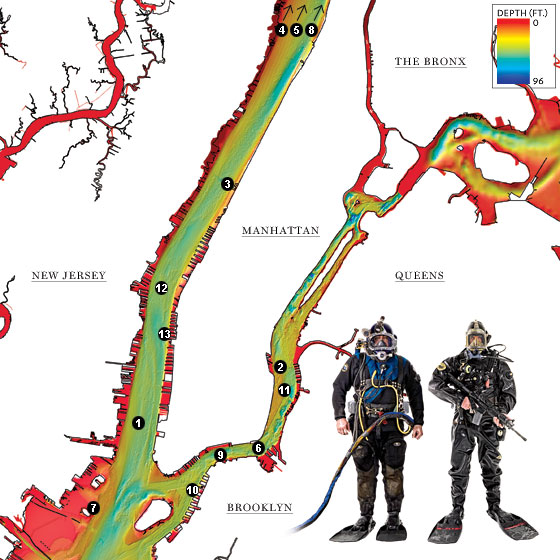
Illustrations by Mark NerysPhoto: Matt Hoyle
The steady transformation of New York’s waterfront from wasteland to playground means more of us are spending time along the city’s edge. That can lead a person to wonder: What, exactly, is down there? Until recently, we had patchy knowledge of what lies beneath the surface of one of the world’s busiest harbors. What we did know came largely from random anecdotes, and depth soundings done the way Henry Hudson did them—by rope and lead sinker. This first GPS-era picture comes from the team at Columbia University’s Lamont-Doherty Earth Observatory, who have methodically swept the lower Hudson with state-of-the-art sonar. LDEO’s Dr. Frank Nitsche stitched together their data, along with several other researchers’ work, into this elegant color-keyed map, which we’ve supplemented by talking with sea captains, historians, and the divers pictured above. There’s a whole other city down there. Here and on the following pages is your guide.
1. A New Main Stream
The Hudson’s main current has, for all of recorded history, clung to lower Manhattan’s edge, skimming along the West Side. Battery Park City, built in the seventies, juts out into that flow, and since then, the current has been cutting a new channel, out toward the center of the river. That current is scraping mud off the top of the Lincoln Tunnel where it never did before; the underwater traffic tubes have lost 25 percent of their soil coverage in some spots. If the tubes ever became exposed, they would be at risk for shifting, cracking, and terrorist threats. The Port Authority is studying solutions.
2. Teredos and Gribbles
Two kinds of hungry pests gnaw away at the pilings that hold up structures like the FDR Drive, the U.N. school on East 25th Street, and the Con Ed plant at 14th. Teredos, which start life looking like tiny clams, grow up to be worms “as big around as your thumb, and nearly four feet long, with little triangular teeth,” says commercial diver Lenny Speregen. Like underwater termites, they devour wood. And Limnoria tripunctata, a.k.a. “gribbles,” are bugs about the size of a pencil dot that look like tiny armadillos, and eat not only wood but also concrete. Speregen says he’s seen fifteen-inch-diameter columns that have been gnawed down, hourglass style, to three inches. The city has tried jacketing pilings in heavy plastic to keep the critters out, but it hasn’t worked well: Floating ice tears up the jackets in winter. “I never said this wasn’t a war,” says Speregen.
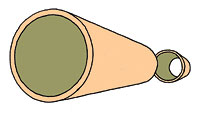
3. A 10,500-Mile Gas Main
That groove on the riverbed is a pair of 24-inch gas mains, laid down in the fifties, that—believe it or not—constitute the business end of a network of pipes that runs all the way from the Gulf of Mexico. (Gas takes roughly a week to make the trip.) This pipeline and another at 134th Street supplied 367 billion cubic feet of gas last year—about half of what we used. Since 9/11, the points where it comes ashore have been patrolled daily.
4. A Pair of Piggybacked Shipwrecks
The LDEO researchers know of at least 300 wrecks in the lower Hudson below Troy, but they won’t tell you where most of them are. “They’re archaeological sites,” says William Ryan, one of the group’s senior scientists, and the state (which funds his research) has concerns about amateur treasure-hunters who can’t handle the currents. One notable wreck, which Ryan will place only “near Yonkers,” includes not one ship but two: A cabin cruiser sits atop the flattened remains of a much older vessel, probably a nineteenth-century sailing ship.
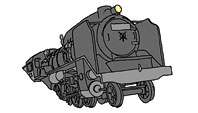
5. A Freight Train
It was carrying passenger baggage one afternoon in 1865, and failed to stop at the Peekskill drawbridge, which was open. Two men were killed.
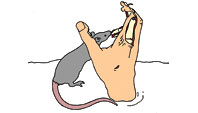
6. Dead Bodies
When homicides and suicides end up in the river during winter, they often stay underwater until April, when decomposition speeds up, bloating them with gases. They then bob up, and currents have been known to drive them to nooks near the Seaport and Manhattan Bridge. “The worst one I ever saw was half in the mud, half out,” says John Drzal, a veteran of the NYPD scuba team. “The skin was peeling back.” He scuttles his fingers up his arm. “The critters were eating it.”
7. Surveillance Systems
The U.S. Coast Guard operates anti-swimmer sonar systems, which are moved around as they’re needed in the harbor. The gear pings signals out, and displays hits—indicating unidentified people or boats—on a video screen. The Coast Guard also does pier sweeps: “If someone puts something on a piling”—say, an electronic device—“we find it,” says USCG gunner’s mate Dave Boles. In 2007, near Liberty Island, he recalls, “someone was spotted in a black Zodiac at night, and we had to check it out.” The mystery boater was never identified.
8. State Secrets
A couple of years ago, “at Kings Point Maritime Academy,” says Boles, “someone dropped a coding device, a piece of secret equipment, and we had to recover it.” (Yes, the guy who dropped it was on our side, and yes, they got it back.)
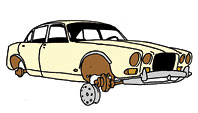
9. Stripped Cars
In the bad old high-crime days, a virtual fleet of auto carcasses ended up in the East River, near the Brooklyn and Manhattan Bridges. One police diver has said that he would tell his partner, “Go to the Chevy, make a left, and if you come to the Dodge you’ve gone too far.” Most were carted away during a cleanup in the eighties, but a number are still down there. Speregen says that the last time he dived nearby, “to be honest, I thought I saw a cement mixer.”
10. Rebar, and a Lot of It
As the coastal beaches and mud flats became docks and roads, the water’s edge has been sharply defined with concrete. Where it cracks, the coast bristles with rusting steel reinforcement bars. Harbor divers have to watch themselves to avoid getting snagged or injured. Random junk tends to collect in and around it: old tires, garbage cans, busted-up bicycles.

11. A Formica Dinette
“In the East River, at about 16th Street, there’s one of those old dining-room tables, the kind with a Formica top and the grooved metal bands around the edge,” says Speregen. “It’s standing upright, totally free and clear. It makes me want to go down there with teacups and set it up.”
12. Another Shipwreck
Unidentified, at 37 feet.
13. Hudson River Alligators
The quaint wooden pilings you see at the edge of Manhattan, the ones that trace the outlines of long-gone piers, are a hazard in the making. When a storm knocks one of them loose, the resultant floater—a “Hudson River alligator”—becomes a twenty-foot battering ram. Army Corps of Engineers patrols scoop them up, but they can’t spot every one. “You’ve seen a SeaStreak, those fast commuter ferries that serve Wall Street?” says Speregen. “One’s gonna get impaled one of these days.”
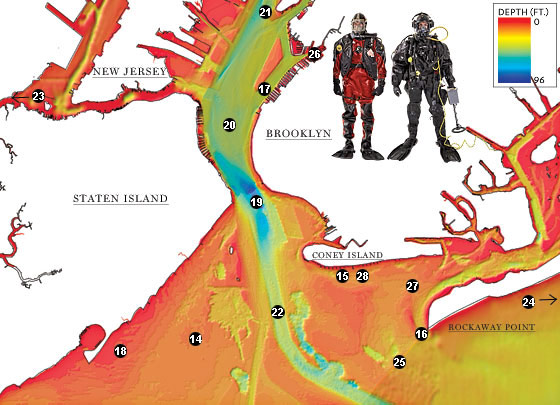
Illustration by Mark NerysPhoto: Matt Hoyle

14. A Piano and a Dead Giraffe
The Army Corps of Engineers, charged with the task of scooping up floating debris, once fished out a grand piano. Another time, they found the corpse of a giraffe that had fled a circus.
15. A 1968 Lincoln Continental
A group of commercial divers spotted the vehicle in 1978 off Coney Island, where it lay, belly-up, twenty feet off the end of the old Steeplechase Pier. “It was probably a polluter for the first twenty years—oil coming up and all that,” says Lenny Speregen. It’s rotting, but “the frame is still there, and the engine block. And the tires, believe it or not.”
16. A 350-foot Steamship
The Princess Anne, a steamship of the Old Dominion line, ran aground off Rockaway Point in February 1920, snapped in half, and sank. Since then, enough sand has shifted that the ship’s remains are mostly buried under the beach.
17. Rats
“One time, I was coming up under a pier,” says Speregen, “and I heard a crash and then something scratching on my helmet. And the guys were saying Go down! Go down! It was a wharf rat, about twelve inches long. It scuttled off. If you get a bite through your glove, you’ve gotta bring the rat up. Even though you’re gonna get the rabies shots either way, you want to know that the rat died.”
18. Less Water Than You Think
This whole bright-red section of the map is less than ten feet deep. Much of it is five feet deep or less—shallow enough to stand in. Yellow and green areas are deeper; dark blue is deepest.
19. The Abyss
The deepest spot in this part of the river—96 feet to the bottom—is found here, just south of the Verrazano-Narrows Bridge.
20. 2,200 Tons of Silt
The harbor’s water is brownish, but not chiefly because of pollution. It’s brown because the Hudson carries an average of 2,200 tons of sediment per day from upstate (more in the autumn and spring, much less in the summer). For divers, all that silt obscures almost everything. “I always say, gimme a foot of viz”—visibility—“and that’s a great day,” says the NYPD’s John Drzal. “Even with a light, you can see just enough to gauge how much air you have left.” It’s a lot like going into a fire, adds Frederick Ill III, a diver from the FDNY’s Rescue Company No. 1. “Except that when you’re on the bottom, and you’ve gotta get out, you’re on your own.”
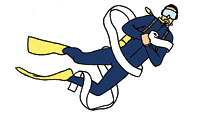
21. Toilet Paper, and All That Goes With It
When there’s a rainstorm, far more water goes into our drainage system than sewage-treatment plants can handle. So the overflow pipes open wide, and all our wastewater—including the untreated effluvia of 8 million people—goes straight into the ocean. The day after a storm, the harbor is brown and thick with stirred-up silt that is shot through with human waste. Sometimes you can see shreds of toilet paper. When divers emerge from the harbor on those days, their suits have to be scrubbed down with bleach or kerosene before the men can strip them off.
22. Out-of-Date Channels
This groove in the harbor bottom is Ambrose Channel, which is the main shipping route into New York Harbor. It’s maintained by the Army Corps of Engineers at a depth of 45 feet. That’s not enough for the biggest new super-container ships, which require 60-foot clearance, and the Corps is finishing up a decadelong project to deepen the channels and tap those ships’ estimated $20 billion worth of commerce. Some of our dredged material contains a century’s worth of pollutants, from mercury to DDT—substances not a lot of places want. At one point, mud was being hauled to a dump in Utah, at the cost of $118 per cubic yard (plain old dumping is about $5 per). Some of it now goes to Texas; some becomes the sandy fill in concrete.
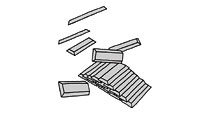
23. 1,600 Bars of Silver, Weighing 100 Pounds Apiece
In 1903, a barge in the Arthur Kill—the oily, mucky arm of the harbor between Staten Island and New Jersey—capsized, spilling its cargo of silver ingots. It carried 7,678 bars; about 6,000 were recovered soon after. The rest are still down there. At today’s prices, they’re worth about $26 million. Every now and then, someone tries to find them. So far, no luck.

24. Ice-cream Trucks
Reefs, because they are good places for edible plants and small animals, attract schools of fish. In 1969, in order to build a new artificial reef, the Department of Environmental Conservation dumped a bargeload of scrapped Good Humor trucks off Atlantic Beach, where they were eventually joined by (according to the DEC) “30,000 tires in three-tire units; 404 auto bodies; nine barges; the tug Fran S; a steel lifeboat; steel crane and boom; surplus armored vehicles; concrete slabs, pipes, culvert, decking and rubble; 530,000 cubic yards of rock from a U.S. Army Corps of Engineers excavation project.” The pile is now known as a good spot for lobstering, and for catching black sea bass, blackfish, porgy, bergall, hake, and cod.
25. Appetizers
There are millions of hard-shell clams on the harbor bottom, but pollutants and bacteria can make the shellfish dangerous to eat, especially raw. Some are okay for “relay,” a process whereby tainted shellfish are moved to a clean spot for a few weeks so they purge themselves and can be safely consumed. Most high-end suppliers and restaurants shy away from such clams, but because they’re much cheaper, some establishments inconspicuously serve them.
26. Oil That’s So Heavy It Sinks
Among the nastiness on the bottom of the Gowanus Canal is a layer of silt mixed with coal tar. Whereas lighter oils like gasoline float away, this goo, which looks like black motor oil, settles in. “When you’re raking along the bottom with your hands,” explains NYPD veteran diver John Drzal, “plumes of it still come up.”
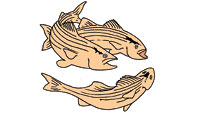
27. More Fish Than You Think
As the water has become cleaner, the shad runs have slowly returned to the Hudson. Striped bass are increasing in number, though their flesh contains PCB contaminants, and eating them regularly isn’t a good idea. A herring called the mossbunker swims in huge schools, and is caught by the ton, ground up, and fed to farmed salmon. There are four-foot-long stingrays down by the Rockaways and off Coney Island, and they’re hard to see when they’re flat against the bottom. A diver will be going about his business when he encounters a section of mud the size of a coffee table that suddenly—zooomp!—up and swims away.

28. The Last Remnants of Dreamland
One of Coney Island’s great early theme parks, Dreamland existed for only a few years before it burned down in 1911. Nothing survives of it aboveground, but a group that Speregen co-founded, called Cultural Research Divers, found the lampposts underwater, melted and deformed from the fire.
Additional data from Dr. Roger Flood, of Stony Brook University, and the National Oceanic and Atmospheric Administration.
